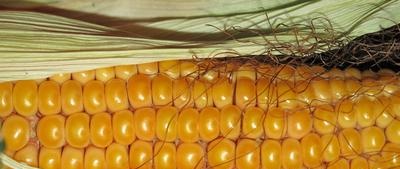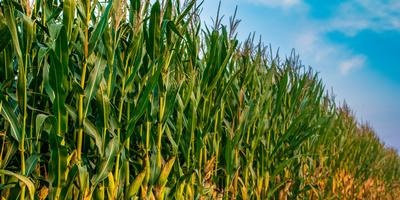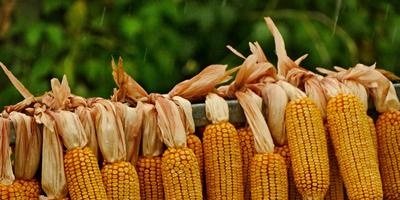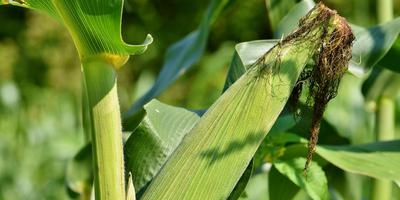|
 It is difficult to say how the inhabitants of the New World would have done if they had not had corn. At least they ate their favorite maize 7000 years ago. And when Christopher Columbus first set foot on the American coast, the Indians were already growing maize on a massive scale. It is difficult to say how the inhabitants of the New World would have done if they had not had corn. At least they ate their favorite maize 7000 years ago. And when Christopher Columbus first set foot on the American coast, the Indians were already growing maize on a massive scale.
Columbus's brother Diego once even got lost in the maize. He walked on them for 18 miles, and they all did not end. The leader of the conquistadors, F. Cortes, suffered even more troubles. His cavalry more than once got stuck in dense thickets of mighty cereal.
But the days are gone. Maize has long been delivered to all continents. In areas, he almost caught up with wheat and rice. And it got accustomed so well that doubts arose.
Maybe maize grew in Asia too? And in Africa? They began to look for the progenitor of maize - wild corn. But until recent years it was not possible to find. We found a lot of unsolved problems, mysteries and ambiguities.
Take, for example, marketable grain. Breeders have succeeded in raising yields. With the help of hybrid vigor - heterosis - they get a double harvest in the first generation of hybrids. But as for the grain size, it was not possible to outmaneuver the Indian gardeners. After Columbus, the Indians developed the Cusco-Gigante variety with grains 50 times larger than that of small-seeded corn. Each grain is the size of a two-corner or apricot pit. Such giants eat in a special way. How is it usually? They will grind the cob into flour, bake cakes or cook porridge - hominy. Cuzco Gigante is not grinded. And hominy don't do it. The grains are boiled, like dumplings, like dumplings, and eaten whole, pried with a fork and dipped in melted butter.
Corn cob cleaners
The Europeans were overjoyed at the maize. So much food! Compared to maize, the usual wheat seemed pathetic and ridiculous. One ear is worth a hundred ears. And he is not alone on the stem. Sometimes there are ten. The beast also quickly appreciated the new food when the corn was exported to Europe.
 The birds make constant raids on plantations, withdraw part of the crop as legal payment for clearing the fields from insects. Farmers believe that birds should work for nothing, which leads to difficult situations. The birds make constant raids on plantations, withdraw part of the crop as legal payment for clearing the fields from insects. Farmers believe that birds should work for nothing, which leads to difficult situations.
The German traveler E. Pöppig more than once witnessed how large, noisy arara parrots devastated corn fields. Feathered beasts arrive inaudibly, sit down on the field and begin to husk the ripening ears. If the owner notices the thieves and grabs the gun, it does not help him much. Parrots set up several sentries in advance - old, well-worn birds. They sit on the tallest trees and sound the alarm. First, a warning one, to which a pack of thieves responds with restrained, dull grunts. When the second is heard, you can no longer hesitate. The "robbers" quit their jobs and rise into the air with such a deafening howl that the farmer has to throw his gun and hold his ears. However, as soon as his back disappears behind the threshold of the hut, the green robbers return. Silently.
And everything starts all over again.
In the temperate zone, where there are no parrots, rooks perform their mission. Rooks are inevitably attracted to corn. Their relationship with the queen of the fields was so tense that in Russia in Russia they were specially dealt with in 1913 by the Yuzhno-Russian Agricultural Gazette. A heated discussion on this issue has opened on its pages. It was started by Professor A. Zaikevich. He sowed corn in two ways. Simple, on a flat field. And into deep furrows. Rooks and jackdaws followed him literally on his heels, picking grain from the ground, as soon as the car piled it from above. However, the birds carried out such an "inventory" only on a flat field. In the furrows, the seed is completely preserved. But the flat fields came closer to the estate, where the birds could always be disturbed and scared away.
On June 27, 1913, an article appeared in the Yuzhno-Russian newspaper. Its essence was as follows. Rook is by nature a cautious bird. Stealing grain, she is always on the alert. He will bite - and immediately head up. Looks around: is there a danger? The rook is trapped in the furrow. From there the review is poor. I can not see anything. Therefore, the bird does not dare to descend into the furrow. The risk is too great. It is easier on a flat field. You can sneak out there in time. Comparing all the facts, the author of the note made a single and very important conclusion: this corn is in the furrows!
This note was published on June 27, 1913 in the 25th issue of the Yuzhno-Russian newspaper. Less than a month later, M. Reznikov's response appeared in number 27. He had just returned from the fields where the corn was sown in furrows. I came to the exact opposite conclusion. His rooks pecked crops in the furrows. On level places, they also dared to appear, but there they managed to drive them away. In the furrows they hid safely and under cover
With the help of the walls, as in a trench, they collected grain calmly and unhurriedly.
“But it could not have been otherwise,” reasoned Reznikov. “What kind of caution can one speak of if the bird calmly walks after the plow, despite the clicking of the whip and the shouts of the driver? And he busily selects harmful larvae from the soil ”. Having reasoned this way, the opponent made his own conclusion: if you want to save the corn, don't go to the furrows!
Two more weeks passed, and on August 1, readers of the newspaper were introduced to the third opinion. Written by the newspaper columnist D. Fedorov. His opinion: it doesn't matter how to sow - in the furrows or not. If only deeper. And most importantly, let the watchmen do not sleep. The birds watch the watchmen vigilantly. A little absent for lunch - they announce an emergency. They fly in a whole flock, like arara parrots. Every minute counts. Several dozen grains are selected per minute.
Baffled by so many different recommendations, agronomists feverishly changed tactics. We tried to plow and sow deeper, but the long nose of the rook got grains from any depth. The seeds were soaked in a resin-and-soap solution. Painted with red lead. In vain! In 1914, a special book "Agricultural value of the rook" was published. In it, the bird was taken apart by the bones. The result was stunning: not going to eat as much corn as harmful insects.
The Rook was acquitted.
 And yet, if you thought well, you could find a Solomon solution. At least the Mexicans found him a long time ago. In tropical areas, they hang the cobs left for seeds from the ceiling of the hut. When a fire is lit in the hearth and food is prepared, the smoke rises to the ceiling. Since there is no pipe, smoke swirls under the dome until it seeps out through 33 And yet, if you thought well, you could find a Solomon solution. At least the Mexicans found him a long time ago. In tropical areas, they hang the cobs left for seeds from the ceiling of the hut. When a fire is lit in the hearth and food is prepared, the smoke rises to the ceiling. Since there is no pipe, smoke swirls under the dome until it seeps out through 33
cracks in the thatched roof. The ears will be soaked with smoke almost through. The grains will be covered with a layer of tar. Germination from tar is not lost, but no one on the field will touch them. No weevil beetle, no birds, no rodents.
But the rook is not alone in the field. Loves corn and crows. When shoots appear, crows roam the field and pull them out. Poaching lasts two or three weeks. And there will be almost no grain left. In the fall, the pilgrimage continues as soon as the ears are ripe. And only the roar of the gun makes them come to their senses. Jays - they are not afraid of guns. But neither jays nor crows are as troublesome as wild boars. Those host at any time. Only a strong fence saves from them. But you can't fence off all the fields. The dilemma is: wild boars or corn? Really, where there are many wild boars, give up corn?
So the first corn-animal problem remained unresolved.
And there are a lot of such problems. But first about the corn itself. It is different. There is a tall one - about eight meters, with a two-story house. And near Lake Titicaca in Bolivia, our friend grows only half a meter. Various and cobs. The progenitor of Cusco-Gigante has cobs almost half a meter long. Maybe they would have grown even more, but there is one limitation. Pollen tubes do not grow more than half a meter. And the length of the cob depends on them.
Distinguish between corn and grain. The most valuable is the dentate. The grains have a dent at the top, like a molar.There is starchy: grains are almost pure starch - 82 percent. There is sugar. Some of the sugars do not condense into starch, but remain so. Now they brought out super sugar. They make delicious canned food.
But the most interesting is pop corn. In Russian - airy, or bursting. The grain is finer than other forms. On the other hand, if you throw wet grains into boiling oil, the water will instantly turn into steam and explode the grain. It will swell with a delicate, almost weightless mass and turn into corn sticks. This pop corn was involved in the history of the origin of the corn genus. To figure out the story, you need to find a starting point - wild corn.
The impression made by the transformation of pop grains into a twentieth-century delicacy was so strong that a young Argentine botanist who took part in the excavations fell ill with a nervous breakdown. Returning home, he reported to the academic council: if someone wants to test their nerves for strength, let them take care of the cave corn.
So what have we learned? That 4000 years ago there was corn, in general, similar to ours. The wild was still far away. And archaeologists rushed to new searches. This time to Mexico, where there were also many different caves. Have checked several of them. We chose one - Coxcatlan. They pounded the bottom of the cave again. And they took out a tiny stump. The maize connoisseur Professor P. Mangelsdorff turned it over in his hands. Finally he nodded in the affirmative: she! Wild! And soon he gave a public lecture. It was a resounding success. Nerd dreams come true! Wild corn found. However, while the fossil.
But then came 1969, and doubts arose. Is it really wild? And if the find is only a stage of domestication? But what if the wild lurks in even deeper depths of millennia? The reason for the doubt turned out to be a plant that is extremely similar to maize. It even earlier belonged to the same genus Zea as maize. Many people still refer. It is an equally prominent herb teosinte. Maize double. "Seeing them growing side by side, even the sharp, trained gaze of an Indian cannot distinguish before flowering." The difference is in the cob. In maize, it is strong, you cannot break it. At teosinte - fragile, as befits savages. Maize has paired spikelets, and theo has single spikelets.
Teosinte is not so rare in nature. In Guatemala, in the mountains, there are thousands of acres. Near houses and at the edges of fields. They call her the "mother of maize" (however, sorghum is also called that).
 So teosinte is the wild ancestor of maize? This has yet to be proven. The first to take up the evidence was L. Burbank. In the hands of Burbank, incomprehensible transformations took place. He bred thornless cacti, pitted plum. Now I undertook to redo the teosinte. Several years of hard work. Careful selection. And a happy ending: theo turned into maize! In 1921, this was reported by the Literary Review and Sunday supplements to various newspapers. So teosinte is the wild ancestor of maize? This has yet to be proven. The first to take up the evidence was L. Burbank. In the hands of Burbank, incomprehensible transformations took place. He bred thornless cacti, pitted plum. Now I undertook to redo the teosinte. Several years of hard work. Careful selection. And a happy ending: theo turned into maize! In 1921, this was reported by the Literary Review and Sunday supplements to various newspapers.
Around the same time, Brazilian breeder M. Bento, independently of Burbank, turned teosinte into maize in just four years! Joking!
And now, before telling what conclusion the scientific world drew from these works, you need to go back a little, to 1888. Then Professor Dugues from Mexico sent a parcel with half a dozen cobs to the Massachusetts Botanical Gardens. They looked like typical corn maize, but very small - a match in length. And the grains looked unusual - like white dog teeth. Have sprouted. A creature has grown, similar to corn and not similar. Called "dog corn". And then Dugues sent a letter: "This is a type of teosinte, we call it 'coyote maize." A hybrid between maize and teosinte. "
The embarrassment was great, but, apparently, it was soon forgotten, because "coyote maize" later misled Burbank and the breeder from Brazil who obtained teosinte maize in four years. That is why I got it so quickly that I worked not with a pure “maize mother”, but with a hybrid! So far, it has not been possible to obtain maize from pure teosinte. However, biologists do not lay down their arms. Too much like the weed of corn fields the queen of the fields herself. Of course, teosinte has an ear, not an ear. But if several ears grow together ...
The relationship between teosinte and maize does not seem to be questioned by anyone. But what is the way to transform the first into the second? Only our compatriot N. Kuleshov managed to outline this path in 1929. His bold hypothesis was later adopted abroad and is still not forgotten. Its essence is as follows. The wild perennial teosinte once crossed with a certain species of sorghum (it is not for nothing that sorghum was called the "mother of maize"). The daughter of this marriage, ancient corn, did not yet look like the modern queen of the fields. She was to marry the Mexican teosinte, which has been discussed so far. With that weed that litters the fields. Finally, we got maize. Present! Although still ancient. The same pop. After all, teosinte was also found in Mexican caves. And teosinte is also capable of producing corn sticks.
Now that everything has fallen into place, it remains to find out where is she, perennial teosinte? Does it exist? Or should we look for it again, like those millennial cobs? Yes, you have to. And for a long time. The best connoisseur of wild teosinte, professor from the University of Wisconsin, H. Iltis, spent eighteen years of his life in search. He recently came to us in Moscow and told the following.
In love with his stranger, the professor even sent New Year's greetings to friends not in ordinary postcards with Santa Claus, but ordered very special postcards. They depict a wild perennial teosinte, its squalid ear-ear and a wide corn-like leaf. How did he know the appearance of the stranger? The fact is that the perennial teosinte was discovered in 1810. But fate wanted to play a cruel joke with the found treasure. In 1921, the few surviving plants ... were eaten by goats! The rarest species has disappeared.
It was in this sad situation that the scientist's Christmas cards played their decisive role. In 1976 he sent one of them to Mexico to a student R. Guzman. He, in response, invited the professor to his place in search of the missing stranger. Together they went to the state of Jalisco. Here, on the outskirts of a tiny village in the foothills of the Sierra de Monantlan, they discovered their treasure. The locals called her chapule.
 Strong supporters of wild corn greeted the news with enthusiasm. In their view, the near future of humanity was completely transformed. We cross with a cultured look. There will be perennial corn. Once you sow, harvest for many years. No soil erosion. Benefits darkness! More sober biologists recalled that annual plants give large grain yields. Perennials have little grain. But of course, there is plenty of greenery. And one more thing: it won't be possible to improve modern corn with the help of wild corn right away. And so in 25 or 50 years! Strong supporters of wild corn greeted the news with enthusiasm. In their view, the near future of humanity was completely transformed. We cross with a cultured look. There will be perennial corn. Once you sow, harvest for many years. No soil erosion. Benefits darkness! More sober biologists recalled that annual plants give large grain yields. Perennials have little grain. But of course, there is plenty of greenery. And one more thing: it won't be possible to improve modern corn with the help of wild corn right away. And so in 25 or 50 years!
However, cultivated maize still has many unsolved problems. Here's one example. During the liberation of the Balkans from the Turkish yoke, Russian doctors who passed through Bessarabia with the troops were surprised by the exceptional safety of the Moldovans' teeth. Even in very old people, spoiled teeth were rare. The doctors explained this by the fact that the population mainly consumes mamalyga - a porridge made from corn flour. Flour contains a substance that prevents dental caries.
It is also worth recalling the episode with corn, described in the book by Paul de Cruy "Fighters against hunger". One of the heroes of the book, chemist D. Bebcock, set up an experiment with feeding cows. He took four groups of heifers and fed each group a specific food. Some heifers were given only wheat, others oats, and others corn. The fourth group received mixed meals. The heifers were growing. And they had calves. And then they also turned into cows. The difference in diet did not affect immediately, but after many years the following became clear: those cows that ate wheat, calves grew sick and died quickly. In the "oatmeal" group, the condition of the young was not much better. Even the mixed group did not produce exemplary calves. And only the corn diet provided full-fledged offspring, and the health of the parents. And although medicine has not yet given an answer to this problem, it is worth thinking about it again.What is the secret of corn grain? And why does the oil that is squeezed out of it serve as a remedy against senile senility?
A. Smirnov. Tops and roots
|
 It is difficult to say how the inhabitants of the New World would have done if they had not had corn. At least they ate their favorite maize 7000 years ago. And when Christopher Columbus first set foot on the American coast, the Indians were already growing maize on a massive scale.
It is difficult to say how the inhabitants of the New World would have done if they had not had corn. At least they ate their favorite maize 7000 years ago. And when Christopher Columbus first set foot on the American coast, the Indians were already growing maize on a massive scale. The birds make constant raids on plantations, withdraw part of the crop as legal payment for clearing the fields from insects. Farmers believe that birds should work for nothing, which leads to difficult situations.
The birds make constant raids on plantations, withdraw part of the crop as legal payment for clearing the fields from insects. Farmers believe that birds should work for nothing, which leads to difficult situations. And yet, if you thought well, you could find a Solomon solution. At least the Mexicans found him a long time ago. In tropical areas, they hang the cobs left for seeds from the ceiling of the hut. When a fire is lit in the hearth and food is prepared, the smoke rises to the ceiling. Since there is no pipe, smoke swirls under the dome until it seeps out through 33
And yet, if you thought well, you could find a Solomon solution. At least the Mexicans found him a long time ago. In tropical areas, they hang the cobs left for seeds from the ceiling of the hut. When a fire is lit in the hearth and food is prepared, the smoke rises to the ceiling. Since there is no pipe, smoke swirls under the dome until it seeps out through 33  So teosinte is the wild ancestor of maize? This has yet to be proven. The first to take up the evidence was L. Burbank. In the hands of Burbank, incomprehensible transformations took place. He bred thornless cacti, pitted plum. Now I undertook to redo the teosinte. Several years of hard work. Careful selection. And a happy ending: theo turned into maize! In 1921, this was reported by the Literary Review and Sunday supplements to various newspapers.
So teosinte is the wild ancestor of maize? This has yet to be proven. The first to take up the evidence was L. Burbank. In the hands of Burbank, incomprehensible transformations took place. He bred thornless cacti, pitted plum. Now I undertook to redo the teosinte. Several years of hard work. Careful selection. And a happy ending: theo turned into maize! In 1921, this was reported by the Literary Review and Sunday supplements to various newspapers. 







































































































































